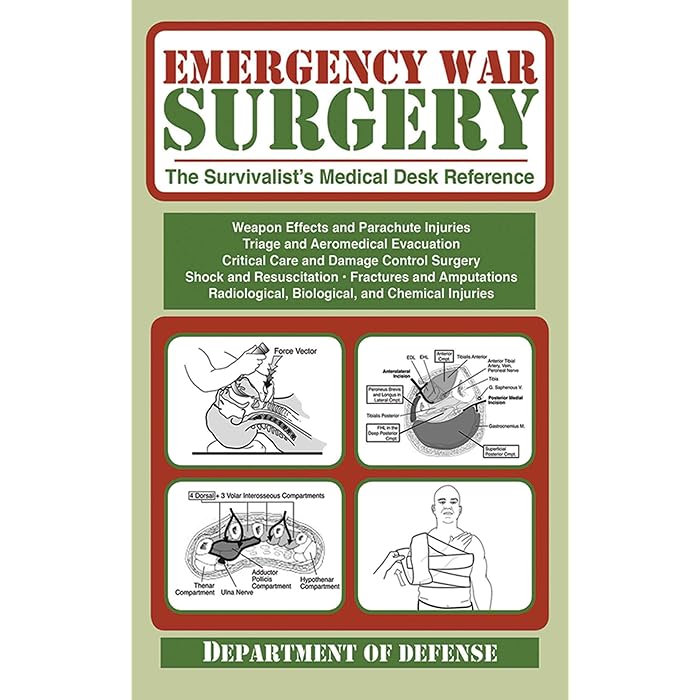Description
**Emergency War Surgery** refers to the medical practices and procedures performed in combat or conflict zones to treat traumatic injuries and life-threatening conditions resulting from war-related violence. These surgeries are often performed under difficult conditions, with limited resources, and in environments that may lack access to advanced medical equipment or sterile conditions. The goal is to save lives, stabilize injured individuals, and provide essential care in the field until more comprehensive medical attention can be provided, if needed.
### Key Aspects of Emergency War Surgery:
1. **Trauma Care:**
– Combat injuries often involve severe trauma, including gunshot wounds, blasts, burns, shrapnel injuries, and fractures.
– The primary objective is to control bleeding, prevent infection, and address life-threatening injuries, such as penetrating wounds to the chest, abdomen, and head.
2. **Triage:**
– Triage is the process of sorting patients based on the severity of their injuries. In a battlefield setting, this involves prioritizing care for those most likely to survive with immediate intervention, while those with more severe or non-survivable injuries may receive palliative care.
3. **Damage Control Surgery:**
– This approach focuses on stabilizing critically injured patients quickly, controlling hemorrhage, and repairing life-threatening damage. The aim is to prevent further complications and allow time for more definitive surgery later in a more stable environment.
4. **Field Hospitals and Mobile Surgical Units:**
– In military settings, field hospitals and mobile surgical units are set up close to the front lines to provide rapid medical care. These units are often equipped with basic but essential surgical tools and supplies, including portable X-ray machines, anesthesia equipment, and blood transfusion capabilities.
– Teams are often made up of surgeons, nurses, anesthesiologists, and other medical staff trained to work under pressure and in austere conditions.
5. **Anesthesia and Pain Management:**
– Administering anesthesia and managing pain in emergency war surgery is challenging due to limited resources. Local anesthesia and regional blocks are commonly used, as general anesthesia can be difficult to perform under field conditions.
6. **Infection Prevention:**
– War wounds are highly prone to infection, especially in non-sterile environments. Surgeons use techniques to reduce infection risk, such as administering antibiotics, cleaning and debriding wounds, and employing temporary dressings or closure techniques.
7. **Amputations:**
– In some cases, especially with severe limb trauma, amputation may be necessary to save a patient’s life or prevent infection. This is typically done as a last resort after all other attempts at saving the limb have been exhausted.
8. **Post-Surgery Care:**
– After surgeries, injured soldiers or civilians may be evacuated to more advanced medical facilities for further treatment and rehabilitation. Medical teams focus on monitoring for complications like infection, hemorrhage, and organ failure.
9. **Psychological Support:**
– Psychological trauma is common in war situations, and military surgeons and medical personnel often work with mental health professionals to address the psychological impact of injury and stress on both patients and medical staff.
### Training and Education:
Military personnel who perform emergency war surgery undergo specialized training that prepares them for the unique challenges of operating in war zones. They often receive training in:
– **Combat medicine** (for basic emergency care and trauma management)
– **Advanced trauma life support (ATLS)**
– **Surgical techniques** tailored to battlefield injuries
– **Field-based anesthesia** and pain management
– **Tactical evacuation** procedures for transporting patients
### History:
The field of emergency war surgery has evolved significantly over time. Major conflicts like World War I, World War II, the Vietnam War, and recent conflicts in the Middle East have all contributed to advancements in trauma care, surgical techniques, and the development of portable medical technologies.
– **World War I and II:** Marked the beginning of more systematic approaches to field surgery, with innovations such as the use of blood transfusions and advances in infection control.
– **Vietnam War:** Saw the rise of mobile surgical units, and advances in trauma care, especially regarding the treatment of penetrating chest wounds and burns.
– **Recent Conflicts (Iraq, Afghanistan):** Led to the use of more sophisticated medical technologies, better armor, and advanced evacuation systems. Surgeons in these settings often perform high-quality trauma care under difficult conditions.





Reviews
There are no reviews yet.